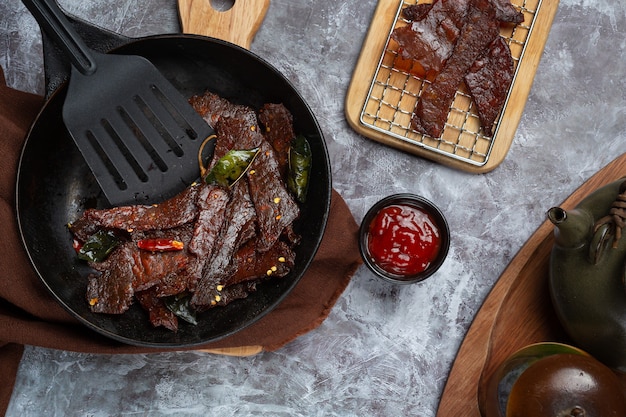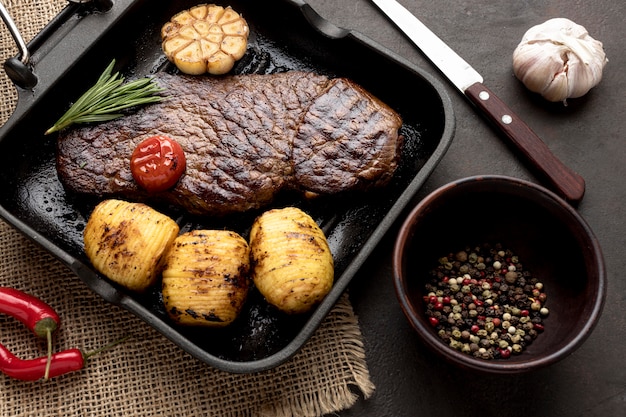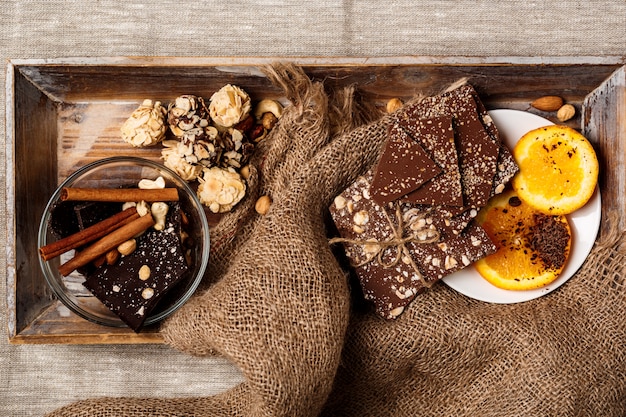There's a certain magic that happens when you sink your teeth into a perfectly cooked ribeye roast. It's not just the juicy, tender meat, but the symphony of flavours, the satisfying crunch of the crust, and the sense of accomplishment that comes with mastering this culinary feat. And let me tell you, it's a feat you can absolutely conquer! I've spent years in the kitchen, experimenting with different techniques and recipes, and I've finally cracked the code for an unforgettable ribeye roast.
This guide isn't just a recipe; it's a journey. We'll delve into everything from selecting the perfect cut of meat to the final resting period, ensuring you get a roast that's juicy, tender, and packed with flavour. It's a roast that will impress your guests, make you feel like a culinary superstar, and have you craving for seconds (and maybe even thirds!).
(Part 1) choosing the right ribeye Roast

The journey to a perfect ribeye roast begins with selecting the right cut of meat. A ribeye is renowned for its rich marbling, that beautiful network of fat that melts during cooking, adding incredible flavour and tenderness. But not all ribeyes are created equal. Let's dive into the details:
Selecting the Cut
You'll want to make sure you're getting a "ribeye roast" and not just a ribeye steak. A roast is a larger, single piece of meat, ideal for feeding a crowd. Now, here are your options:
- Bone-In: This is the classic choice, and for good reason. The bone adds flavour and helps the meat cook more evenly. Imagine a little culinary hug from the bone, embracing the meat and ensuring perfect results. While it might be a bit more challenging to carve, the extra flavour and tenderness make it worth the effort.
- Boneless: This is the easier option for carving, but some say it lacks the extra flavour of the bone. Ultimately, the choice comes down to personal preference. I, for one, am a die-hard fan of the bone-in roast.
- Standing rib roast: This is the fancier option, often with the bone in a beautiful spiral shape, like a culinary crown. It's typically more expensive, but it makes a stunning presentation on the table. It's a showstopper, perfect for special occasions.
Now, let's talk weight. You'll need to decide how many people you're feeding. A general rule of thumb is about 1 pound (450 grams) per person. But if you're serving a bunch of hungry folks (or if you're like me and can't resist a good leftover), you might want to go a bit heavier. Always better to have a little extra!
Finally, marbling. This is where the magic really happens. Look for a roast with good marbling, meaning a nice distribution of fat throughout the meat. This fat is like a culinary conductor, ensuring a symphony of flavours and a truly juicy, tender roast. When you cut into the roast, you should see those beautiful streaks of fat, a sign that you're on your way to culinary greatness.
(Part 2) The Prep Work

Now that you've got your perfect ribeye roast, it's time to get your hands dirty! Don't worry, it's not a messy process, just a little bit of hands-on love for your meat.
Seasoning the Roast
For me, seasoning is an art form. It's about creating a balance of flavours that complement the richness of the ribeye. My go-to is a simple blend of salt, pepper, and garlic powder. It's a classic combination that highlights the natural flavour of the meat. But feel free to get creative with herbs and spices to create your own unique signature blend. Here's how I typically tackle seasoning:
- Pat the roast dry with paper towels. This helps the seasoning adhere, creating a beautiful, even crust. Think of it like prepping the canvas before painting a masterpiece.
- Season generously with salt on all sides. Salt is your secret weapon here. It draws out moisture and helps create that delicious, crispy crust. Don't be shy, embrace the salt! Think of it as a whisper of flavour, promising a burst of deliciousness.
- Add black pepper, freshly ground for optimal flavour. You can't go wrong with a generous amount of pepper. It adds a touch of heat and complexity to the overall flavour profile. Think of it as the bold counterpoint to the salt's subtle whisper.
- Optional: Feel free to sprinkle in garlic powder, onion powder, paprika, or any other spices you love. I sometimes add a touch of dried rosemary for a hint of earthy flavour, a subtle note that blends beautifully with the other spices.
- Rub the seasoning in with your hands, ensuring it coats the entire surface of the roast. This is your moment of connection with the food, a little ritual before the magic begins. Imagine transferring your passion and excitement into the meat.
The Fat Cap
The fat cap is that beautiful layer of fat on top of the roast. It's not just a visual delight; it's a key ingredient for juicy, flavourful meat. Here's how to handle this culinary gem:
- Leave it alone! Don't trim it off. This fat will render and baste the roast, keeping it incredibly tender and moist. Think of it as a natural marinade, adding depth and richness to the flavour.
- Score the fat cap. This helps the fat render more evenly, creating that beautiful, crispy crust. Use a sharp knife and make shallow, diagonal cuts across the fat cap, about 1/4 inch apart. Imagine creating little pathways for the fat to release its flavour.
(Part 3) Cooking the Roast

This is where the real magic happens! You have a few options for cooking your ribeye roast, each with its own unique charm. Let's explore them:
The oven method
This is my go-to method for a perfect, evenly cooked roast. It's a tried and true technique that consistently delivers delicious results. Here's my foolproof oven method:
- Preheat your oven to 450°F (230°C). This high initial temperature is key for creating a delicious, crispy crust. Think of it as a culinary welcome mat, setting the stage for a flavourful journey.
- Place the roast on a rack in a roasting pan. This allows for even air circulation, helping the fat render efficiently and ensuring a perfectly cooked roast. The rack is your roast's personal stage, allowing it to shine.
- Roast for 15 minutes, then reduce the oven temperature to 325°F (160°C). The initial high heat creates that mouthwatering crust while the lower temperature ensures even cooking throughout the roast. It's a beautiful dance between heat and time.
- Roast for 15 minutes per pound for medium-rare, or adjust the time according to your desired level of doneness. A meat thermometer is your best friend here! It takes the guesswork out of cooking and ensures perfect results every time.
- Let the roast rest for at least 15 minutes before carving. This is a crucial step, allowing the juices to redistribute throughout the meat, resulting in a much juicier and more flavorful roast. Think of it as a moment of relaxation for the roast, allowing it to fully savour its culinary journey.
The reverse sear Method
For a perfectly tender and evenly cooked roast, the reverse sear method is a culinary game-changer. It involves cooking the roast at a low temperature for a longer period, followed by a quick sear to create a beautiful crust. It's a method that takes patience, but the results are worth every minute.
- Preheat your oven to 275°F (135°C). This low temperature allows the meat to cook slowly and evenly, resulting in a remarkably tender and juicy roast. Imagine a slow, gentle simmer, coaxing the best out of the meat.
- Place the roast on a rack in a roasting pan and cook for about 2 hours, or until the internal temperature reaches 120°F (49°C). This ensures the meat is cooked through and incredibly tender, like a culinary hug that melts away any toughness.
- Increase the oven temperature to 450°F (230°C) and roast for another 15 minutes, or until the roast reaches your desired internal temperature. This final burst of heat creates a beautiful, crispy crust, a perfect contrast to the tender interior. Think of it as the finishing touch, adding a touch of magic to your culinary creation.
- Let the roast rest for at least 15 minutes before carving. This allows the juices to redistribute, ensuring a truly succulent and flavorful roast. Imagine the juices travelling through the meat, creating a symphony of flavour in every bite.
The Grill Method
For those who love the smoky aroma and char marks of grilling, you can definitely cook your ribeye roast on the grill. Just remember, grilling a roast takes a little more finesse than grilling a steak. Here's how to do it like a pro:
- Prepare your grill for indirect heat. This means having a side with medium heat and a side with no heat. Imagine creating a little culinary oasis for your roast, with the gentle warmth of indirect heat.
- Place the roast on the cooler side of the grill. Cook for about 20 minutes per pound, turning the roast every 15 minutes. This ensures even cooking, preventing the roast from drying out. Think of it as a slow, gentle dance between heat and meat.
- Move the roast to the hotter side of the grill for the last 10 minutes to sear and create a delicious crust. This final burst of heat adds a beautiful char and a touch of smoky flavour, a little culinary flourish that elevates the roast to new heights.
- Let the roast rest for at least 15 minutes before carving. This allows the juices to redistribute, ensuring a tender and flavourful roast, ready to be devoured.
(Part 4) The Importance of Resting
Resting your roast isn't just a suggestion, it's a crucial step in the process. Think of it as a chance for the roast to relax, savour its culinary journey, and prepare itself for the grand finale. Resting allows the juices to redistribute throughout the meat, resulting in a more tender, juicy, and flavorful roast. It's a simple step that makes a big difference.
- Tent the roast with aluminium foil. This traps the heat, allowing the juices to redistribute evenly. Think of it as a little culinary blanket, keeping the roast warm and cozy.
- Let the roast rest for at least 15 minutes. For larger roasts, you can rest it for up to 30 minutes. The longer the roast rests, the more time the juices have to redistribute, creating a truly impressive result.
(Part 5) Checking for Doneness
You've cooked your ribeye roast, but how do you know if it's cooked to perfection? It's all about finding that sweet spot, that perfect balance between tenderness and doneness. Here are a few ways to check:
The Touch Test
This is a classic method, but it takes practice. Press the center of the roast with your finger. It should feel firm but slightly springy for medium-rare. Imagine pressing a marshmallow - firm, yet yielding. This is the feel you're looking for.
The Thermometer
This is the most reliable method, leaving no room for guesswork. Insert a meat thermometer into the thickest part of the roast, making sure it doesn't touch any bones. Here are some recommended internal temperatures, your guide to culinary perfection:
| Doneness | Internal Temperature |
|---|---|
| Rare | 125°F (52°C) |
| Medium-Rare | 130°F (54°C) |
| Medium | 140°F (60°C) |
| Medium-Well | 150°F (66°C) |
| Well-Done | 160°F (71°C) |
(Part 6) Carving the Roast
Now comes the moment of truth, the grand finale! Carving the roast is more than just cutting into the meat; it's a chance to showcase your culinary skills and create beautiful slices that will impress your guests. It's about taking your culinary creation from a masterpiece in the oven to a work of art on the table.
- Use a sharp carving knife. This will ensure clean, even slices, like a sculptor carving a masterpiece. A dull knife will create uneven cuts, ruining the visual appeal and affecting the tenderness of the meat.
- Slice against the grain of the meat. This is a culinary secret, helping to make the meat more tender and easier to chew. Imagine slicing through the muscle fibers, creating a tender and succulent bite.
- Don't be afraid to ask for help if you're not confident in your carving skills. There's no shame in getting a second pair of hands, especially when it comes to a beautiful roast. It's all about enjoying the process and creating a memorable meal for everyone.
(Part 7) Serving Your Roast
You've put so much effort into your ribeye roast, so make sure you present it in a way that does it justice. It's about creating a visual feast, a presentation that complements the deliciousness of the roast.
The Presentation
A beautiful roast deserves a beautiful presentation. Consider serving it on a platter or wooden board, garnished with fresh herbs or vegetables. Think of it as creating a culinary landscape, a visual symphony that complements the flavours of the roast.
Accompanying Dishes
Choose sides that complement the rich flavour of the ribeye. Roasted vegetables, creamy mashed potatoes, or a light salad are all excellent choices. Imagine a culinary ballet, where each dish complements the other, creating a harmonious symphony of taste.
(Part 8) Leftovers
Let's be honest, the best part of a good roast is the leftovers. Don't let them go to waste! They are a culinary treasure, a reminder of the delicious feast you've just enjoyed.
- Store the leftover roast in an airtight container in the fridge for up to 3 days. This helps maintain its freshness and prevents it from drying out.
- Reheat the roast in the oven or on the stovetop. You can also slice it and use it in sandwiches, salads, or pasta dishes. The possibilities are endless! Leftovers are a blank canvas, allowing you to create new culinary adventures.
FAQs
- Q: How long should I cook a ribeye roast for?
A: The cooking time for a ribeye roast depends on the weight of the roast and your desired level of doneness. Generally, you should cook the roast for about 15 minutes per pound at 325°F (160°C) for medium-rare. But remember, a meat thermometer is your best friend, ensuring perfect results every time.
- Q: Can I cook a ribeye roast in a slow cooker?
A: I wouldn't recommend cooking a ribeye roast in a slow cooker. The slow cooker will likely make the meat too tough and mushy. The best methods for a ribeye roast are the oven, reverse sear, or grilling, ensuring a juicy, tender, and flavorful result.
- Q: What's the best way to get a crispy crust on my ribeye roast?
A: A high initial oven temperature (450°F) is essential for a crispy crust. You can also sear the roast on the stovetop before roasting it, adding a touch of smoky flavour and enhancing the crust's deliciousness.
- Q: What can I do with the leftover fat from the roast?
A: Don't throw away the fat! It's a culinary goldmine, adding richness and depth to any dish. Strain it and use it for cooking other dishes, like potatoes, vegetables, or even for making homemade gravy. It's a flavour bomb, a little bit of culinary magic in every drop.
- Q: What are some good wine pairings for a ribeye roast?
A: A full-bodied red wine like Cabernet Sauvignon, Merlot, or Zinfandel will complement the rich flavor of the ribeye. You could also try a lighter red wine like Pinot Noir or a fruity red blend, creating a harmonious dance of flavours. Let your taste buds be your guide!
There you have it! My ultimate guide to cooking a perfect beef ribeye roast. It's more than just a recipe, it's a culinary adventure. With these tips and techniques, you'll be serving up a delicious, tender, and flavourful roast that will have everyone asking for seconds. Remember, cooking is about experimentation and finding what works best for you. So, get in the kitchen, have fun, and enjoy the journey of creating a culinary masterpiece!
Everyone is watching

How to Cook Frozen Lobster Tails Perfectly: A Step-by-Step Guide
RecipesLobster. Just the word conjures up images of lavish meals, special occasions, and a taste of luxury. But let's...

Pigs in a Blanket Cooking Time: How Long to Bake for Perfect Results
RecipesAh, pigs in a blanket. Just the name conjures up images of those delightful little parcels of crispy pastry en...

Pork Fillet Cooking Time: How Long to Cook It Perfectly
RecipesPork fillet, or tenderloin as it's sometimes called, is a real favourite in our house. It's so versatile, and...

The Ultimate Guide to Tender, Juicy Pulled Pork
RecipesRight, let's talk pulled pork. It's one of those dishes that just screams "comfort food," doesn't it? I mean...

The Ultimate Guide to Cooking Sweet Potatoes: From Roasting to Mashing
RecipesSweet potatoes. Just the name conjures up images of warm, comforting dishes, bursts of vibrant color, and a to...
